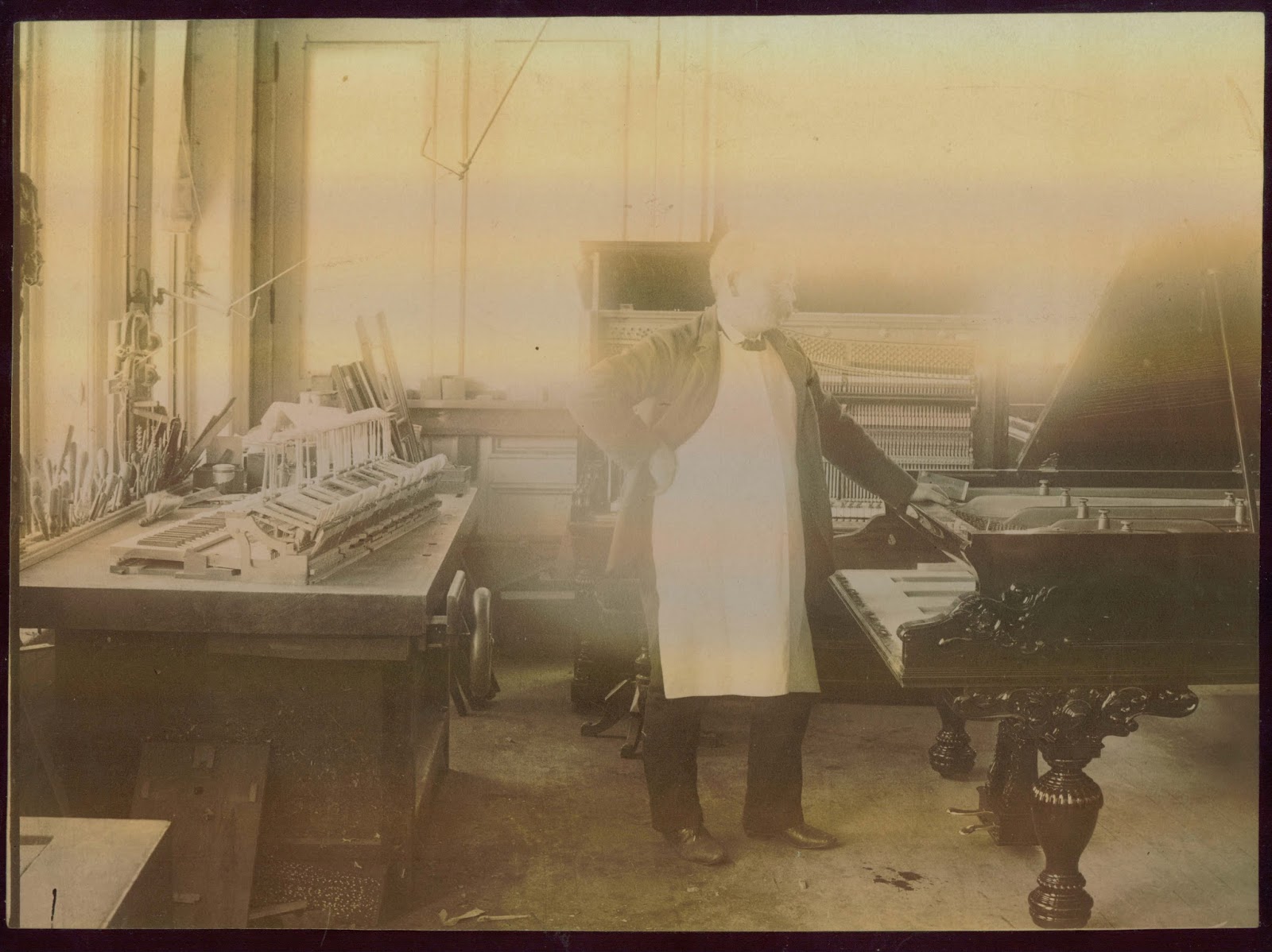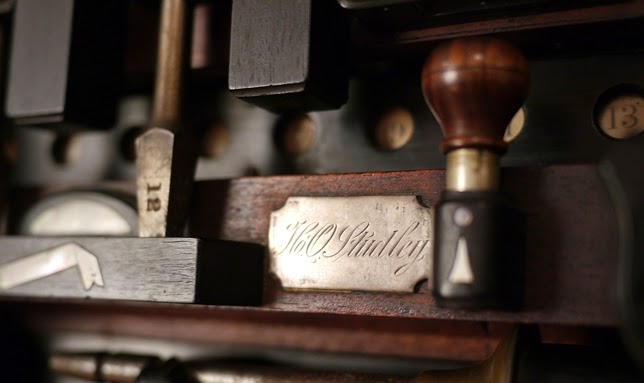If woodworking ever rose to the level of religion, there would be mini-versions of the Studley Tool Chest hanging behind the cash register of every ethnic grocery store this side of the Meditteranean.
I don't have a relationship with my tools. But if I did, I would build a temple for them. And that's what Henry Studley did with his tools. He built a sacred space for these objects and enshrined them within, replete with the same sort of embellishments and details that one sees in the great European cathedrals. Gothic arches, turned columns, delicately carved finials, inlays of precious materials, symbolism. An attention to detail that causes one to marvel.
I don't know much about Studley's background, or what type of person he was. But what is obvious from his chest is that he felt a connection with his craft that few, if any of us will ever experience. Is this a good thing? I don't know. For me, I have a different relationship with woodworking and tools. For me they are simply a means to an end. Not an end in and of themselves. At first glance, Studley's chest looks like the latter. But as an object of human skill and creativity, as an expression of his skill as a piano maker, perhaps this does reflect the creative energies of the divine that lurk within all of us. In that light, I have nothing but respect for Studley's creation. If you ever have the opportunity to see the chest, do not miss it.
Last year at
Handworks I was invited by Don Williams to aid him in examining the hand wheel-equipped vises of Studley's bench, in hopes of someday producing a small run of these unique, and rare vises. Examining the two vises we discovered a number of new clues as to their history and construction. Incidentally, of the 18 or so extant vises, no two are alike, although several share an overall similarity in design. No patent records have been found, and only one historical photograph of a piano maker's shop featuring the vise has been found.
![]() |
| Photo courtesy of Patrick Leach |
The vises themselves are quite interesting. They almost all feature a sliding "drawer and box" construction, either with a tongue and groove keying the box to the drawer, or a sliding dovetail with gibs (like a powered jointer bed.) In the case of the Studley vises, the machined surfaces of the castings were shaped, not cut with a rotary tool. If you're not familiar with a metal shaper, its not like the woodworking machine of the same name. It's also known as a metal planer. The distinctive marks made by the shaper are easy to identify. They leave straight lines rather than circular.
One of the vises we examined had the number 6 stamped on several parts. Look close.
What did this mean? It could have been a way to identify parts that belong to a particular vise, or perhaps it was a serial number. Studley's vise in the tail vise position is the only one we know of with a metal dog dovetailed into the jaw itself. Because of this I always assumed Studley retrofitted the dog on his particular vise. But if that's the case, why would he bother stamping the "6" into the dog?
The dog fits sweetly into the jaw and receives its tension via a brass slug and spring. It's quite nice.
Once we'd examined the vises in their natural position, we pulled the bench away from the wall and flipped the top over to get a closer look at each vise's undercarriage. We were talking about the solid mahogany top and how heavy it was when we took a closer look into one of the holes that key the top onto the base via a dowel. The top is in fact veneered. We couldn't determine the core species. Don thought perhaps oak. Honestly, it was too difficult to tell.
With the top belly up, I got a closer look at Studley's dogs. I've always been fascinated by these. And now I know exactly how they work. The dogs fit very well in their holes. Not too sloppy, not tight. Just right. The brass spring keeps the dog peeking out of its hole at a given height. The brass tongue screwed to the underside of the top provides a stop against the groove in the base of each dog, preventing them from falling out.
Once the bosses arrived we were forced to wrap up our investigation. One minute I was wearing white gloves and examining an historical artifact with "The Don", to unloading strange pieces of foam rubber from the back of Narayan's turbo encabulator-equipped Volvo man wagon. Paddle shifters are pretty cool, but I didn't know you could get a bluetooth tranny on these. Shifting while texting is so convenient.
The remainder of the day was spent much like a photo shoot here at Benchcrafted. Holding umbrellas in odd positions, bracing the tripod against my body so as not to cause permanent damage, advising the photographers on white balance and proper emulsion techniques, all the while keeping the chimping to a minimum.
The room the chest resides in is quite non-descript. Yet the space has a certain energy. Perhaps even a metaphysical quality. Studley's shrine of tooldom brings out the most interesting, almost cult-like behavior.
At one point Schwarz appeared before chest bearing a large gold disc in his left hand. He assumed a sort of meditatively empty stare, and while averting his eyes from directly looking at the chest, aimed the gold disc at the shrine.
As the golden light washed over the surface, a genie emerged from the chest and took over the entire operation. For the remainder of the day, I did everything the genie asked, in exchange for one wish at the end of the day.
Shooting the empty chest requires removal of all the tools. I gladly sat by and watched the magic happen.
The first tools to come out were the planes, among which was the transitional Stanley jack plane, with rosewood body. I've never seen or heard of one of these before (I'm no Stanley expert), and Don tells me he's never heard of another. It wasn't a rework by Studley. It's stamped "Stanley..." at the toe.
As tools emerged, I was able to observe some of Studley's trick joinery. Sweet little dovetails. These are tiny.
I had a few moments to get really close to the chest and examine a few of the more well-known elements, like the iconic dividers-and-square. I'd love to post these, but they are not Studley-worthy. Wait until
Don's book by
LAP comes out, which will be full of the best pictures of every living detail of the chest and its tools. And in case you're wondering, I didn't touch the chest, or any of the tools inside. I had no good reason to, so why risk it?
As Don and Chris removed tools, I realized there was just too much to take in. I wanted to look at every tool, especially Studley's own shop made tools. I just couldn't do it all in the time I had. That's why I'm looking forward to the book. Viewing the chest as a complete piece (tools in place) was awesome. Really. It's like looking into the mechanism of a fine watch.
The empty chest is also something. It gives a chance to really examine the detail that Studley put into the supports, apart from the clever arrangement. I've read about this on Schwarz's blog, many of the ebony supports feature a tiny little cove scratched into the edge of the support, especially the ebony pieces. It gives the entire piece a sparkle as they catch the light. It's beautiful.
One of the highlights of my visit was being able to compare our fully machined handwheels with their inspiration. The Studley handwheels are so sweet. They are more or less perfect. I have no doubt that Studley spent a lot of time working his wheels by hand to achieve such a level of finish. They are beautiful to see and touch. Real works of industrial art.
For a few short moments I felt like I owned this stuff. U can't touch this.
As I said my goodbyes to The Don, shook the hand of the owner, and gave Schwarz a big bear hug, I turned to the genie, reminding him of my hours of unflinching servitude throughout the day, and his promise of granting me one wish. A big grin spread across his face from ear to ear, a twinkle of light sparkled in his eye, and with a deep, satisfying laugh my wish was granted.
Photos of the plaid gorilla by Narayan Nayar. Digital effects by Harry Toopay Studios. All other photos by your's truly.












































